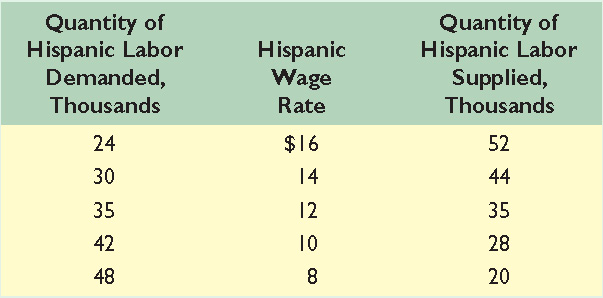1. What is the estimated size of the union wage advantage? How might this advantage diminish the efficiency with which labor resources are allocated? 2. The labor demand and supply data in the following table relate to a single occupation. Use them to answer the questions that follow. Base your answers on the taste-for-discrimination model.  <a onClick="window.open('/olcweb/cgi/pluginpop.cgi?it=jpg::::/sites/dl/free/0073273090/384253/KeyQuestion_Ch34_Graph01.jpg','popWin', 'width=NaN,height=NaN,resizable,scrollbars');" href="#"><img valign="absmiddle" height="16" width="16" border="0" src="/olcweb/styles/shared/linkicons/image.gif"> (49.0K)</a> <a onClick="window.open('/olcweb/cgi/pluginpop.cgi?it=jpg::::/sites/dl/free/0073273090/384253/KeyQuestion_Ch34_Graph01.jpg','popWin', 'width=NaN,height=NaN,resizable,scrollbars');" href="#"><img valign="absmiddle" height="16" width="16" border="0" src="/olcweb/styles/shared/linkicons/image.gif"> (49.0K)</a>- Plot the labor demand and supply curves for Hispanic workers in this occupation.
- What are the equilibrium Hispanic wage rate and quantity of Hispanic employment?
- Suppose the white wage rate in this occupation is $16. What is the Hispanic-to-white wage ratio?
- Suppose a particular employer has a discrimination coefficient d of $5 per hour. Will that employer hire Hispanic or white workers at the Hispanic-white wage ratio indicated by part c? Explain.
- Suppose employers as a group become less prejudiced against Hispanics and demand 14 more units of Hispanic labor at each Hispanic wage rate in the table. What are the new equilibrium Hispanic wage rate and level of Hispanic employment? Does the Hispanic-white wage ratio rise or fall? Explain.
- Suppose Hispanics, as a group, increase their labor services in this occupation, collectively offering 14 more units of labor at each Hispanic wage rate. Disregarding the changes indicated in part e, what are the new equilibrium Hispanic wage rate and level of Hispanic employment? Does the Hispanic-white wage ratio rise, or does it fall?
3. Use a demand and supply model to explain the impact of occupational segregation or "crowding" on the relative wage rates and earnings of men and women. Who gains and who loses from the elimination of occupational segregation? Is there a net gain or net loss to society? Explain. 4. Use graphical analysis to show the gains and losses resulting from the migration of population from a low-income country to a high-income country. Explain how your conclusions are affected by (a) unemployment, (b) remittances to the home country, (c) backflows of migrants to their home country, and (d) the personal characteristics of the migrants. If the migrants are highly skilled workers, is there any justification for the sending country to levy a "brain drain" tax on emigrants? |

